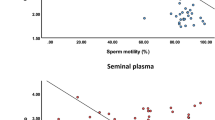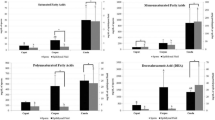Abstract
Purpose
To determine if levels of very long chain polyunsaturated fatty acids (VLC-PUFA; ≥ 28 carbons;4-6 double bonds) in human sperm correlate with sperm quantity and quality as determined by a complete semen analysis.
Methods
Ejaculates from 70 men underwent a complete semen analysis, which included volume, count, motility, progression, agglutination, viscosity, morphology, and pH. For lipid analysis, sperm were pelleted to remove the semen. Lipids were extracted from the cell pellet and methyl esters of total lipids analyzed by gas chromatography. The sphingolipids were enriched and sphingomyelin (SM) species measured using tandem mass spectrometry. Pair-wise Pearson correlation and linear regression analysis compared percent VLC-PUFA-SM and percent docosahexaenoic acid (DHA) to results from the semen analysis.
Results
VLC-PUFA-SM species having 28–34 carbon fatty acids were detected in sperm samples, with 28 and 30 carbon VLC-PUFA as most the abundant. The sum of all VLC-PUFA-SM species comprised 0 to 6.1% of the overall SM pool (mean 2.1%). Pair-wise Pearson analyses showed that lower levels of VLC-PUFA-SM positively correlated with lower total motile count (0.68) and lower total count (0.67). Total VLC-PUFA-SM and mole % DHA (22:6n3) were not strongly correlated (− 0.24). Linear regression analysis confirmed these findings.
Conclusion
This study revealed a positive correlation between the levels of VLC-PUFA with sperm count and total motile count and suggests that both sperm quality and quantity may depend on the presence of VLC-PUFA. The lack of correlation between VLC-PUFA and DHA suggests that low VLC-PUFA levels do not result from inadequate PUFA precursors.




Similar content being viewed by others
References
Furland NE, Oresti GM, Antollini SS, Venturino A, Maldonado EN, Aveldaño MI. Very long-chain polyunsaturated fatty acids are the major acyl groups of sphingomyelins and ceramides in the head of mammalian spermatozoa. J Biol Chem. 2007;282(25):18151–61.
Poulos A, Johnson DW, Beckman K, White IG, Easton C. Occurrence of unusual molecular species of sphingomyelin containing 28-34-carbon polyenoic fatty acids in ram spermatozoa. Biochem J. 1987;248(3):961–4.
Stoffel W, et al. Delta6-desaturase (FADS2) deficiency unveils the role of omega3- and omega6-polyunsaturated fatty acids. EMBO J. 2008;27(17):2281–92.
Roqueta-Rivera M, Stroud CK, Haschek WM, Akare SJ, Segre M, Brush RS, et al. Docosahexaenoic acid supplementation fully restores fertility and spermatogenesis in male delta-6 desaturase-null mice. J Lipid Res. 2010;51(2):360–7.
Esmaeili V, Shahverdi AH, Moghadasian MH, Alizadeh AR. Dietary fatty acids affect semen quality: a review. Andrology. 2015;3(3):450–61.
Agbaga MP, Mandal MN, Anderson RE. Retinal very long-chain PUFAs: new insights from studies on ELOVL4 protein. J Lipid Res. 2010;51(7):1624–42.
Bennett LD, Anderson RE. Current Progress in deciphering importance of VLC-PUFA in the retina. Adv Exp Med Biol. 2016;854:145–51.
Aveldano MI. A novel group of very long chain polyenoic fatty acids in dipolyunsaturated phosphatidylcholines from vertebrate retina. J Biol Chem. 1987;262(3):1172–9.
Aveldano MI, Sprecher H. Very long chain (C24 to C36) polyenoic fatty acids of the n-3 and n-6 series in dipolyunsaturated phosphatidylcholines from bovine retina. J Biol Chem. 1987;262(3):1180–6.
Cooper TG, et al. World Health Organization reference values for human semen characteristics. Hum Reprod Update. 2010;16(3):231–45.
Kruger TF, et al. Sperm morphologic features as a prognostic factor in in vitro fertilization. Fertil Steril. 1986;46(6):1118–23.
Folch J, Lees M, Sloane Stanley GH. A simple method for the isolation and purification of total lipides from animal tissues. J Biol Chem. 1957;226(1):497–509.
Brush RS, Tran JTA, Henry KR, McClellan ME, Elliott MH, Mandal MNA. Retinal sphingolipids and their very-long-chain fatty acid-containing species. Invest Ophthalmol Vis Sci. 2010;51(9):4422–31.
Busik JV, Reid GE, Lydic TA. Global analysis of retina lipids by complementary precursor ion and neutral loss mode tandem mass spectrometry. Methods Mol Biol. 2009;579:33–70.
Ford DA, Monda JK, Brush RS, Anderson RE, Richards MJ, Fliesler SJ. Lipidomic analysis of the retina in a rat model of Smith-Lemli-Opitz syndrome: alterations in docosahexaenoic acid content of phospholipid molecular species. J Neurochem. 2008;105(3):1032–47.
Yu M, Benham A, Logan S, Brush RS, Mandal MNA, Anderson RE, et al. ELOVL4 protein preferentially elongates 20:5n3 to very long chain PUFAs over 20:4n6 and 22:6n3. J Lipid Res. 2012;53(3):494–504.
Guzick DS, Overstreet JW, Factor-Litvak P, Brazil CK, Nakajima ST, Coutifaris C, et al. Sperm morphology, motility, and concentration in fertile and infertile men. N Engl J Med. 2001;345(19):1388–93.
Bonde JP, et al. Relation between semen quality and fertility: a population-based study of 430 first-pregnancy planners. Lancet. 1998;352(9135):1172–7.
Van Voorhis BJ, et al. Effect of the total motile sperm count on the efficacy and cost-effectiveness of intrauterine insemination and in vitro fertilization. Fertil Steril. 2001;75(4):661–8.
Merviel P, Heraud MH, Grenier N, Lourdel E, Sanguinet P, Copin H. Predictive factors for pregnancy after intrauterine insemination (IUI): an analysis of 1038 cycles and a review of the literature. Fertil Steril. 2010;93(1):79–88.
Fritz MA, Speroff L, editors. Clinical Gynecologic Endocrinology and Infertility. 8th ed. Vol. Chapter 30. 2012. p. 1272–1275.
Sassa T, Kihara A. Metabolism of very long-chain fatty acids: genes and pathophysiology. Biomol Ther (Seoul). 2014;22(2):83–92.
Ahumada-Gutierrez H, Peñalva DA, Enriz RD, Antollini SS, Cascales JJL. Mechanical properties of bilayers containing sperm sphingomyelins and ceramides with very long-chain polyunsaturated fatty acids. Chem Phys Lipids. 2019;218:178–86.
Lenzi A, et al. Lipids of the sperm plasma membrane: from polyunsaturated fatty acids considered as markers of sperm function to possible scavenger therapy. Hum Reprod Update. 1996;2(3):246–56.
Gulaya NM, Margitich VM, Govseeva NM, Klimashevsky VM, Gorpynchenko II, Boyko MI. Phospholipid composition of human sperm and seminal plasma in relation to sperm fertility. Arch Androl. 2001;46(3):169–75.
Tang LX, Yuan DJ, Wang QL, Jiang F, Guo J, Tang YG, et al. Association of decreased spermatozoa omega-3 fatty acid levels and increased oxidative DNA damage with varicocele in infertile men: a case control study. Reprod Fertil Dev. 2016;28(5):648–54.
Safarinejad MR, Hosseini SY, Dadkhah F, Asgari MA. Relationship of omega-3 and omega-6 fatty acids with semen characteristics, and anti-oxidant status of seminal plasma: a comparison between fertile and infertile men. Clin Nutr. 2010;29(1):100–5.
Zadravec D, Tvrdik P, Guillou H, Haslam R, Kobayashi T, Napier JA, et al. ELOVL2 controls the level of n-6 28:5 and 30:5 fatty acids in testis, a prerequisite for male fertility and sperm maturation in mice. J Lipid Res. 2011;52(2):245–55.
Rabionet M, van der Spoel AC, Chuang CC, von Tümpling-Radosta B, Litjens M, Bouwmeester D, et al. Male germ cells require polyenoic sphingolipids with complex glycosylation for completion of meiosis: a link to ceramide synthase-3. J Biol Chem. 2008;283(19):13357–69.
Acknowledgments
We thank Sonny Icks of the Dean McGee Eye Institute for his invaluable assistance with all matters related to IRB approvals and updates. We also thank Michelle Scruggs, RN, and Kisha Turner, RN, for their assistance in recruitment, consenting, and data management. And finally, we thank Dr. Sixia Chen for statistical assistance.
Funding
This work was supported by the Presbyterian Health Foundation Team Science Grant (L.B.C, R.EA and M-P.A), the National Institutes of Health Grants EY04149 (R.E.A.) and P30EY021725 (R.E.A); an unrestricted grant from Research to Prevent Blindness to the University of Oklahoma Health Sciences Center’s Department of Ophthalmology; OU College of Medicine Alumni Association, BrightFocus Foundation, and Oklahoma Center for Advancement of Science and Technology to M-P.A; and the Oklahoma Shared Clinical and Translational Resource Institute (NIGMS U54 GM104938).
Author information
Authors and Affiliations
Corresponding author
Ethics declarations
Conflict of interest
LB Craig, MT Sullivan, and MT Zavy declare that they have no conflicts of interest. RS Brush, MP Agbaga and RE Anderson have a US Patent for biological synthesis of VLC-PUFA (United States Patent 8,021,874 B2).
Ethical approval
All procedures performed in studies involving human participants were in accordance with the ethical standards of the institutional and/or national research committee and with the 1964 Helsinki declaration and its later amendments or comparable ethical standards.
Informed consent
Informed consent was obtained from all individual participants included in the study.
Research involving human participants
Research involved human participants. Institutional Review Board approval was obtained prior to initiating the trial.
Disclaimer
The content is solely the responsibility of the authors and does not necessarily represent the official views of the National Institutes of Health.
Additional information
Publisher’s note
Springer Nature remains neutral with regard to jurisdictional claims in published maps and institutional affiliations.
Electronic supplementary material
ESM 1
(DOCX 27 kb)
Rights and permissions
About this article
Cite this article
Craig, L.B., Brush, R.S., Sullivan, M.T. et al. Decreased very long chain polyunsaturated fatty acids in sperm correlates with sperm quantity and quality. J Assist Reprod Genet 36, 1379–1385 (2019). https://doi.org/10.1007/s10815-019-01464-3
Received:
Accepted:
Published:
Issue Date:
DOI: https://doi.org/10.1007/s10815-019-01464-3




